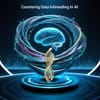Data inbreeding is a growing concern in the field of artificial intelligence (AI). It occurs when AI models are trained on data that is overly similar or homogeneous, resulting in models that are not robust or generalizable to new, unseen data. This can lead to biased or inaccurate predictions, and can even perpetuate existing social inequalities.
Data inbreeding can arise from a variety of sources, including data collection methods, data preprocessing techniques, and model selection procedures. For example, if a dataset is collected from a single source or population, it may not be representative of the broader population, leading to biased models.
To counter data inbreeding, researchers and practitioners can employ several strategies. One approach is to use data augmentation techniques, which involve artificially increasing the diversity of the training data through techniques such as rotation, scaling, or adding noise. Another approach is to use transfer learning, which involves training a model on one dataset and then fine-tuning it on a second, more diverse dataset.
Additionally, researchers can use techniques such as data blending, which involves combining multiple datasets to create a more diverse and representative training set. They can also use methods such as active learning, which involves selectively sampling the most informative data points to add to the training set.


